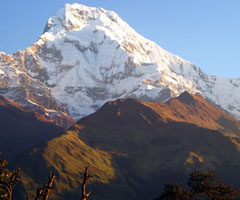
» Ville fjell og vennlige mennesker
» Nepalsk ornitolog kikket pa Lista
» Namaste Nepal passer for reiseskildringer














&
Temparature
Everest Close - Up
19 Days in Nepal 14 Days Challenging Trekking
 The snowcapped summit of Everest, world’s highest peak at 29,035’, looms over the Khumbu region of Nepal. Beneath the icy faces of Everest and its neighboring giants, Nuptse and Lhotse, the Khumbu welcomes the foreign trekker with its Sherpa hospitality. The beauty of the Khumbu’s soaring peaks and green valleys led to the establishment of the first
national park in the Himalaya: Sagarmatha National Park, after Everest’s Nepali name. Besides
Mountain panoramas of Everest, Ama Dablam, Kantega and Thamserku, we experience the rich Sherpa culture. The route begins at Lukla, where we land on a runway surrounded by 20,000’ peaks. From there we ascend the river valley to Kala Patthar (18,200’), visiting Namche Bazaar, Khumjung and Pangboche monasteries, and other villages along the way. At the head of the valley, Kala Patthar provides unobstructed views of the south and west faces of Everest. We then venture past the Khumbu Glacier’s tall ice seracs to enter the famed Everest Base Camp.
The snowcapped summit of Everest, world’s highest peak at 29,035’, looms over the Khumbu region of Nepal. Beneath the icy faces of Everest and its neighboring giants, Nuptse and Lhotse, the Khumbu welcomes the foreign trekker with its Sherpa hospitality. The beauty of the Khumbu’s soaring peaks and green valleys led to the establishment of the first
national park in the Himalaya: Sagarmatha National Park, after Everest’s Nepali name. Besides
Mountain panoramas of Everest, Ama Dablam, Kantega and Thamserku, we experience the rich Sherpa culture. The route begins at Lukla, where we land on a runway surrounded by 20,000’ peaks. From there we ascend the river valley to Kala Patthar (18,200’), visiting Namche Bazaar, Khumjung and Pangboche monasteries, and other villages along the way. At the head of the valley, Kala Patthar provides unobstructed views of the south and west faces of Everest. We then venture past the Khumbu Glacier’s tall ice seracs to enter the famed Everest Base Camp.
Participants in this trek should be in good physical condition, as we hike at elevations of up to
18,200’. Along the route, we’ll take breaks and meet the locals in tea houses, villages, Buddhist
monasteries and marketplaces.
Detailed Itinerary
Day 01 Arrival in Kathmandu meet and transfer to our hotel.
Day 2 We enjoy a full day in Kathmandu. In the morning, we take a guided sightseeing tour of the Hindu site of Pashupatinath and the Buddhist site of baudhanath. The afternoon is open for final trek preparations and a little exploring. We may visit the city center at Durbar Square and enjoy the shops, restaurants and evening street life in the lively Thamel Area.
Day 3 We fly to Lukla (9,186’) and begin the trek. This initial section follows the Dudh Koshi River Valley through a relatively rich agricultural area. The Sherpas in these villages raise large crops of corn, potatoes, wheat, turnips, cauliflower, and cabbage, and tend herds of cows, sheep, Goats, and yak cross-breeds. Interspersed between villages stand magnificent forests of magnolia, rhododendron and fir trees. As we hike, watch the cliffs above the river for a glimpse of musk deer and Himalayan tahr. We’ll visit the gompa (monastery) at Phakding, largest in the Pharak district and spend the night in the village at 8,300’.
Day 4
At Jorsale the trail enters Sagarmatha National Park, established in 1976 with the support of the New Zealand government. The remaining stretch to Namche Bazaar (11,286’) is steep. A prosperous market and administrative center for the Khumbu Region, Namche is the largest townin the area.
Day 5 After yesterday’s challenging hike, we spend a day exploring Namche. This allows us time to rest and acclimatize.
Day 6 We hike to Khumjung (12,434’). This village, more traditional in appearance than Namche, is the location of the Hillary School, a primary and secondary school financed by the Himalayan Trust, the philanthropic organization established by Sir Edmund Hillary. We visit the village monastery, where relics of the yeti (the Abominable Snowman) may be viewed for a donation.
Day 7 We enjoy a morning hike up the Imja Khola Valley to Phortse (12,500¢), an impressively perched village that dominates the entrance to the valley.
Day 8 Continuing higher up the valley, we arrive at the summer settlement of Pheriche. Located here are the summer pastures and fields of Sherpas who live lower in the valley, grazing their yaks and growing barley here in the warmer months. The setting is one of alpine meadows and splendid mountain vistas.
Day 9 Today we rest and acclimatize in Pheriche (13,920¢). Taking a day hike or ascending a smaller peak or ridge nearby passes the time and helps us adjust to the elevation. We follow the time-tested adage: Trek high, sleep low.
Day 10 We ascend the wide valley to Phalang Karpo (14,240¢). The trail climbs steeply onto the terminal moraine of the Khumbu Glacier, and then descends to Duglha (15,158¢). We pass a cluster of monuments to climbers and Sherpas who have perished in mountaineering accidents, and arrive at the summer village of Loboche (16,207¢).
Day 11 We leave Loboche at dawn to ascend Kala Patthar. The trail becomes increasingly rough and steep as we approach Gorak Shep (17,349’). Soon we pass a small and often frozen lake, and continue upward to Kala Patthar (18,192¢). We catch our breath at the top and survey one of the most magnificent mountain panoramas in the world: the south and west faces of Mount Everest (29,035¢) and its entourage of neighboring peaks, Lhotse and Nuptse. We look down on Everest Base Camp where mountaineers are assembled. Everest, the world’s highest mountain, was first Climbed in 1953 by Sir Edmund Hillary and Tenzing Norgay. Its Nepali name, Sagarmatha, means “Churning Stick of the Ocean of Existence.” The Sherpas call it by its Tibetan name, Chomolungma, which means “Mother Goddess of the Universe.” The name we know comes from
Sir George Everest, who was head of the Survey of India from 1823-1843. We return to Loboche for the night.
Day 12 We trek into the famed Everest Base Camp. Our route takes us along the Khumbu Glacier and moraine, and past seracs, tall ice towers found on glaciers of the Himalayas.
Day 13 We return down the valley to Pheriche.
Day 14 We walk through a beautiful rhododendron forest to the monastery of Thyangboche (12,700¢). Destroyed by a fire in 1989, this gompa is currently under reconstruction. At Thyangboche the mountain panorama is one of the most breathtaking in the Khumbu. From this vantage point, the massive Nuptse-Lhotse Wall conceals all but the tip of Everest. Rising above the monastery is “Mother’s Charm Box,” Ama Dablam (22,494¢). The name stems from a mountain formation said to resemble a dablam, a charm box worn by female residents of the Khumbu and Tibet.
Days 15-16 We return to Namche and follow the rushing Dudh Koshi River through lovely forest, past mani stones and water-driven prayer wheels back to Lukla.
Days 17-18 We fly from Lukla to Kathmandu. The extra day serves as a cushion in case flight departure from Lukla is delayed. If the flight operates on time, we have an extra day in Kathmandu.
Day 19 We depart from Kathmandu Namaste flight to your home.
The following information will allow you to better plan your budget for tours or treks. A range of costs is given. These costs are dependant on:- The mix of Touring and/or general Trekking,
- The remoteness of the areas visited,
- The number of guides or porters required,
- The standard of accommodation required (if there is a choice),
- The type of ground transport used,
- The length of your visit, and
- The size of your group.
Depending on group size the costs of treks and tours range from:
1 to 3 pax US$ 88 to 163 P/p per night.
4 to 8 pax US$ 78 to 148 P/p per night
9 to 14 pax. US$ 75 to 135 P/p per night.
15 to 20 and above US$ 60 to 110 P/p per night
Single supplement US$ 40 to 70 per night.
Note: The itinerary and cost for Peak climbing, Mountaineering, Tibet, Bhutan and India tours and trek are conditional apply.
Notwithstanding the costs shown above, we can tailor tours to suit almost any budget. Feel free to email us for more information.
Note: One tour leader will be free of cost for tours with 15 or more paying guests only.
Children's bellow three years is free if sharing with their parents. And need to pay if they are participating on the trekking, and above three to nine year children half of the price.
Cost Includes: Accommodation in 3 to 4 star hotels in the cites as your choice, basic accommodation in a lodge or tea house or camping (depending on your itinerary and choice) during treks, guides and porters on treks, all land transfers by private vehicle, 3 meals a day on treks, all jungle safaris, all sightseeing tours as per itinerary and all necessary entry fees, permits and airport transfers.
Cost Excludes: Personal expenses, domestic air tickets, airport tax, drinks (soft drink, mineral water and alcoholic beverages and hot-shower on the trek), personal insurance, and extra cost due to natural calamities or accidents outside of our control.
Please note that our guides speak the following English languages and if required we will provide your language spiking guide on extra cost.
Note: Please contact exploretrek@wlink.com.np for more information and prices
Translate
Contact Information:
Alpine Explore NepalP.O. Box: 4546, Kathmandu, Nepal
+977 1 4700714 / 4700175 / 4701974
Fax: +977 -1 - 4700970
Email: info@traveltrek.asia
sales@traveltrek.asia
Skype Address: explore.alpine
MSN Messanger: explorealpine
Yahoo Messanger:explorealpine

Unlimited Everest Rolwaling Trek with Panorama Views Amazing Annapurna Manang, Tilicho Lake and Thorangla-Pass Jomsom Manaslu and Annapurna Hidden Valley Trek, Manang Everest with High Pass Trekking Upper Mustang TrekWestern Nepal Dolpo Rara Lake Trek


Our Guest Says
SteveAnyon-Smith18 April 2000
This was my third trek in Nepal, having visited the Annapurna Region in 1995 and with Bharat and Dave in the beautiful and wildlife-filled Langstang Valley in1998. Bharat's company "Explore Alpine Adventure"....












